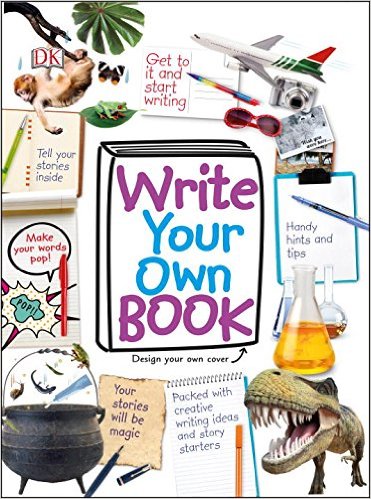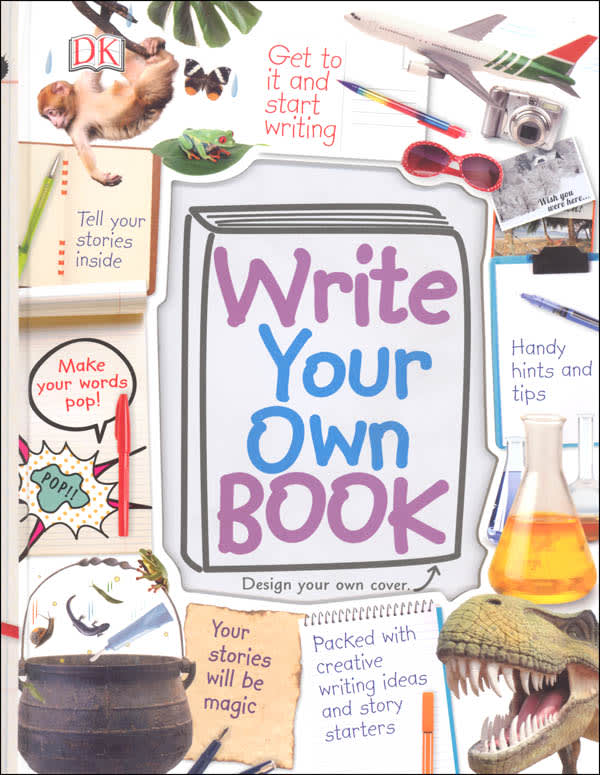Both eager and reluctant writers are likely to find Write Your Own Book much more motivating than textbook exercises for creative writing. Like most other DK books, this one is loaded with full-color images and graphics, and it should be intriguing to students in about third through sixth grades.
Write Your Own Book helps children write their own story, but that doesn’t really happen until page 70 of this 96-page book. The first 70 pages are writing prompts that explore different aspects of storytelling. Every two-page spread has a different theme—if one doesn’t motivate your child, try another. Fairy tales, heroes and villains, movie scenes, imaginary pets, scary stories, famous places, whodunnits, vacations, and space adventures are only a few of the themes. While most writing exercises are creative, one directs them to write instructions for a magic spell. I realize that some parents might want to skip this one, but consider having them substitute writing instructions for cooking or for an art or building project.
Within each theme, children work on different elements of storytelling such as plot, setting, description, characters, using more interesting words, point of view, relating emotions, and dialogue. Occasionally they are asked to draw things like a wanted poster, a map of an imaginary land, or the opening scenes of a story in comic-strip style.
Students write, draw, and color directly in their book. Often, students will be writing a short segment rather than a complete story. Sometimes, they will write a descriptive piece or a piece of a potential story in response to the writing prompts. In this first section, there are a few instances where students are to write a complete story with a beginning, middle, and ending, but these are intended to be brief—there is only one formatted page on which they are to write for each of these. Once such instance specifically tells student to write their story in fifty words or less.
You might find that students don’t have enough space on the formatted pages for a number of their writing exercises, at which point you will need to decide whether to provide some of your own formatted pages or have them continue in a notebook of some sort.
Activities work on both structure and style, but not in a “building-blocks” fashion. There is some progression—the first lesson deals with plotting the story, and writing dialogue doesn’t show up until page 48. However, skipping around, or even omitting some activities, should be fine. A number of activities help children to become wordsmiths, encouraging them to choose the most colorful or action-packed words. Because of this, students should have access to both a dictionary and a thesaurus as they work through the writing activities.
Pages 66 through 69 wrap up the first part of the book. Pages 66 and 67 have some checklists for students to use for self-editing on grammar, spelling, and punctuation, while pages 68 and 69 have a glossary.
Students begin to write their own lengthier story on page 70. This section of the book is very sequential. It walks students through a logical sequence for building their story. They think of a theme and a title. Then they plan their story describing the opening, the setting, the action, the climax, the conflicts, and the resolution. They describe their characters and draft a conversation between their characters to convey distinct characterizations. After they work out the setting for the story, they are ready to draft their opening. They will also draft the climax and the ending before they tackle the entire story. Through all of these steps, students will be drawing upon skills they learned or practiced in the first section of the book. You might think of the first 70 pages as serving as the warm-up for the big event.
As students begin to write their complete story, they should probably work on preliminary drafts elsewhere, perhaps even on a computer. Fifteen formatted pages at the back of the book are for the student to write their story, but these pages should probably be reserved for writing the final draft of the completed story.
The book has a plastic spiral binding within a hard-cover. This makes the book sturdy enough to stand up to the heavy-duty usage it will receive, and it also allows it to lie entirely flat so that students can easily write in it.
Summary
Write Your Own Book has an entirely different feel than that of most resources designed for use in educational settings. Motivated children might use it just for fun. However, I expect that it is likely to prove most useful with reluctant writers. While I wrote that the suggested audience is grades three through six, you could easily use Write Your Own Book with junior-high students who need the kid-friendly format of this book to inspire them to tackle creative writing.









